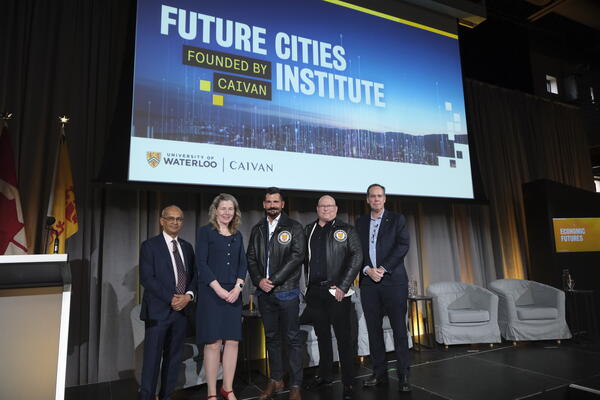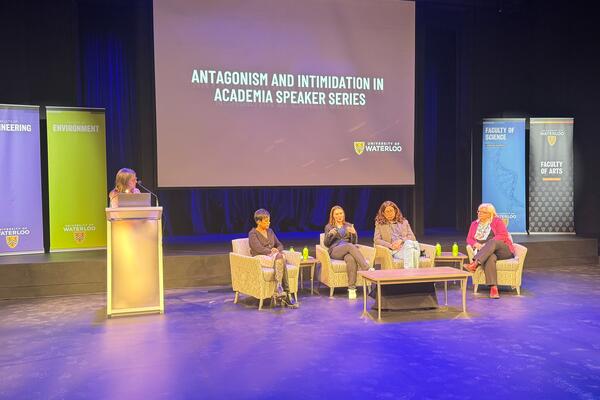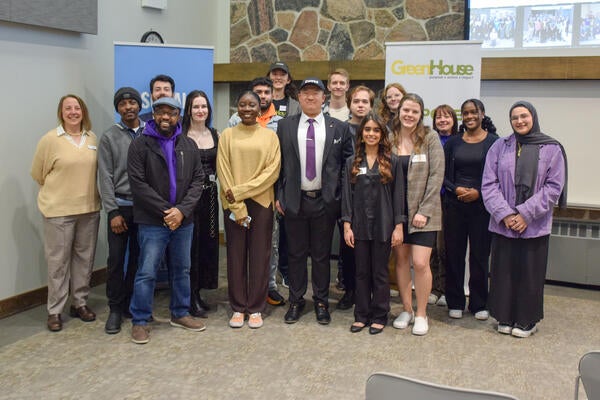
University of Waterloo engineering students show top projects next week
Upper-year undergraduate students in six University of Waterloo engineering programs will display innovative design projects over several days starting next Monday

Upper-year undergraduate students in six University of Waterloo engineering programs will display innovative design projects over several days starting next Monday
By Media RelationsWATERLOO, Ont. (Tuesday, March 15, 2011) - Upper-year undergraduate students in six University of Waterloo engineering programs will display innovative design projects over several days starting next Monday.
At Engineering Design Symposium Week, nearly 700 senior engineering students will present more than 150 design projects, posters and prototypes to the public, industry guests, alumni and the academic community.
"Engineering Design Symposium Week is a tremendous opportunity to view first-hand the work of our talented engineering students as they near graduation," said Adel Sedra, dean of Waterloo Engineering. "The inventive design projects on display represent months of hard work and effort by our students."
All events will be held at the William G. Davis Computer Research Centre, located on the main University of Waterloo campus. Visitors are encouraged to browse the interactive displays and discuss the projects with the students.
• Monday, March 21, from 1 p.m. to 5 p.m. Students graduating from mechatronics engineering will exhibit projects in the areas of autonomous systems, medical systems, mechatronics sports systems and reconfigurable service systems.
• Wednesday, March 23, from 9:30 a.m. to 8 p.m. Students graduating from electrical and computer engineering will showcase their design projects in the areas of audio/video processing, energy and power, robotics, input devices, tracking, security, software and entertainment systems.
• Friday, March 25, from 9:30 a.m. to 6 p.m. Students graduating from nanotechnology engineering will present their design projects in the areas of nanofluidics and nano-biotechnology, nanophotonics and electronics and nano-functional materials.
• Friday, March 25, from 9:30 a.m. to 6 p.m. Students graduating from software engineering will demonstrate innovative projects on software systems for mobile devices, desktop computers, embedded systems and cloud computing.
• Monday, March 28, from 10:30 a.m. to 5 p.m. Third- and final-year students in systems design engineering will exhibit projects in the areas of human and biomedical engineering, mechatronics, financial and environmental systems.
Among the projects to be featured are the following:
• BufferBox® - Mechatronics design symposium
BufferBox is a self-service parcel delivery kiosk for neighbourhoods which allows recipients same day, 24-hour access to missed deliveries. BufferBox provides a highly cost-efficient, self-sustainable, accessible technology to lower costs for shipping carriers while increasing value to receivers. The project has been awarded first place in the Nicol Entrepreneurial Award Competition and the Innovation Award in the Queen's Entrepreneur's Competition.
• Intelligent Power Management Module - Electrical and computer engineering design symposium
The Intelligent Power Management Module provides a design that adapts to power consumption patterns and controls access between the power grid and power circuitry of devices in order to manage power usage for devices not in use. The prototype plugs into a power outlet and acts as a buffer between the electric grid and the electronic device, studying the usage pattern of the device. A dynamic signal is generated at different times of the day to dictate whether the device should be powered at a particular time. The prototype uses a memory chip to store the usage pattern and an electronic relay to cut off power to the system based on the data. The simple design is financially beneficial, environmentally friendly and demands little human intervention.
• Head Monster - Electrical and computer engineering design symposium
Head Monster is a portable system that produces a virtual 3D audio experience. It combines positional and rotational information about the listener to create the illusion that sounds originate from various points in their physical environment. By interfacing sensors with a computing device, the system calculates the position of the user relative to virtual sound sources. The computing device then transforms preset audio signals to match the virtual environment and streams them to a mobile device, which plays back the transformed sounds to a set of stereo headphones. The proposed solution is more portable, more immersive and less disruptive than a sound system with speakers situated around the user.
• Nano Sensor for Toxin Detection - Nanotechnology design symposium
Ensuring that everyday environments are free of harmful toxins requires a variety of time-consuming tests, each looking for a different type of toxin. What if all of these tests could be combined into one simple measurement? The project examines a biochemical sensing technique in which each toxin generates its own unique "fingerprint" based on interactions between gold nanoparticles and fluorescent molecules. Using this technique, a wide variety of toxins can be identified using one simple test.
• Counterfeit Detection - Nanotechnology design symposium
Imagine two luxury products placed side by side. One is authentic and one is fake, but they look almost exactly the same. How to tell which one is authentic? The project provides an innovative counterfeit detection feature by using colour combinations of quantum dots, identifiable under UV light, which can be used to authenticate the real product.
• Retinoscopy Simulator - Software symposium
A retinoscope is an instrument that allows optometrists to obtain an objective measurement of the refractive error of the eyes of a patient. Retinoscopy, the use of a retinoscope, is a technique that is subject to human error. In the project, a simulator for retinoscopy is developed. The simulator is designed to help students overcome the steep learning curve of using a retinoscope and assess their performance. The project aims to improve on current teaching methods of retinoscopy by using an interactive, all-in-one, software system.
• Systems design symposium
Projects presented at the systems design symposium will include an autonomous robot to collect tennis balls, a hardware accelerated equity trading system optimized for a cross market strategy and an adaptive feed-forward controlled electo-acoustic system to reduce noise emanating from a range hood.
Waterloo Engineering acknowledges the sponsorship of Infusion Angels, Infusion Development, Qualcomm Incorporated, Maplesoft and the ASME (American Society of Mechanical Engineers) in recognition of the achievements of senior engineering undergraduate students.
About Waterloo Engineering
The faculty of engineering at the University of Waterloo is a multi-faceted engineering school with eight academic units, home to about 270 faculty members, more than 1,840 graduate students and 6,340 undergraduate students. More than 33,000 alumni have made their mark in industry, academe and the public sector, in Canada and around the world. For further information, go to www.engineering.uwaterloo.ca.

Read more
The gift comes from two Waterloo alumni with passion and drive to have transformative impact

Read more
University of Waterloo researchers discuss the challenges faced by researchers amid rising antagonism in climate science discourse

Read more
GreenHouse awards more than $14,000 to five student founded ventures making an impact towards several UN Sustainable Development Goals
The University of Waterloo acknowledges that much of our work takes place on the traditional territory of the Neutral, Anishinaabeg and Haudenosaunee peoples. Our main campus is situated on the Haldimand Tract, the land granted to the Six Nations that includes six miles on each side of the Grand River. Our active work toward reconciliation takes place across our campuses through research, learning, teaching, and community building, and is co-ordinated within the Office of Indigenous Relations.